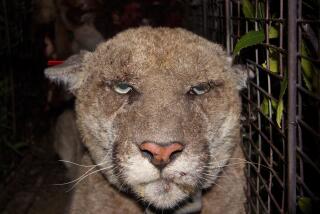A crash course for whales
Hawaii’s navigational hazards usually run to shoals, reefs and other vessels. But from December through April, another obstacle surfaces: humpback whales.
The local whale-watching industry has come under scrutiny since the Christmas Day death of a 3-year-old boy, who reportedly hit his head after the boat in which he was riding either collided or had a close encounter with a humpback off Oahu. The boy’s family has filed a lawsuit against the boat’s captain and owners, claiming negligence.
Then on Jan. 5, a fisherman off Maui was knocked unconscious after an apparent collision with a humpback. All Sandy Parker remembers was seeing the whale surface about 20 feet in front of his boat and turning to try to avoid hitting it. He woke up with head injuries that required 20 stitches and 12 staples to close.
With Hawaii’s humpback population growing 7% annually, the number of collisions has jumped from two between 1975 and 1984 to 13 from 1995 to 2003, said David Mattila, science and rescue coordinator for the Hawaiian Islands Humpback Whale National Marine Sanctuary. The Christmas incident is the first known to have resulted in a fatality.
Humpbacks, which can weigh as much as 45 tons, often surface and breach near boats, which is the appeal — and risk — of lingering in their midst.
— Pete Thomas
Monuments to grizzly deaths
In Montana, that vehicle-sized object jumping into the lane ahead could be a grizzly.
There have been enough collisions with the bears that the nonprofit Great Bear Foundation, based in Missoula, Mont., has proposed placing markers where grizzlies have been killed, similar to the white crosses marking where people have died in traffic accidents.
The project is the idea of Chuck Jonkel, the group’s president and a renowned bear researcher.
He plans on having a metal bear silhouette crafted for use as a roadside marker.
Jonkel, a former professor at the University of Montana, said there are at least eight sites near Yellowstone and Glacier national parks where grizzlies have been killed by motorists.
He said the markers would serve two purposes: to remind drivers about the closeness of nature, and heighten their awareness that a bear could be crossing the road.
— J. Michael Kennedy
Showdown at Algodones
To off-road enthusiasts, the vast Algodones Dunes 160 miles east of San Diego are a fat-wheel mecca. To environmentalists, these sandy dunes in the Imperial Valley are a fragile habitat for the Peirson’s milk vetch, a small, broom-like plant protected by the Endangered Species Act that is at the center of an outdoor dust-up. The plant’s protected status bans vehicles from a 77,000-square-acre area where the milk vetch grows, leaving 68,000 acres open to vehicles.
But off-roaders complain that the milk vetch’s protection is a misuse of environmental laws, touting a study paid for by motor recreationists that concludes vehicles have not harmed the plants.
Environmentalists point to government studies that helped declare the milk vetch a threatened species as evidence that opening the area to vehicles would push the plant into extinction.
The Bureau of Land Management has said it will spend $850,000 this year to send workers into the dunes to count the plants, according to state officials. Meanwhile, riders have successfully petitioned for a federal review of the evidence that protected the Peirson’s milk vetch. An answer is expected in May.
— Charles Duhigg
Get a grant, save a species
The U.S. Fish and Wildlife Service is looking for a few good conservation projects.
The service is seeking projects under its Private Stewardship Grants Program, which has $7.1 million to spend for conservation efforts on private land. The program distributes the money to individuals and groups engaged in conservation efforts that benefit imperiled species.
Last year, the service awarded 113 grants totaling more than $9.4 million for conservation efforts in 43 states. Among them were a $100,000 grant to help restore habitat on the Teton River in Idaho and another for $127,000 that reduced threats to imperiled species in Hawaii.
The wildlife service manages the 95-million-acre National Wildlife Refuge System.
— J. Michael Kennedy






